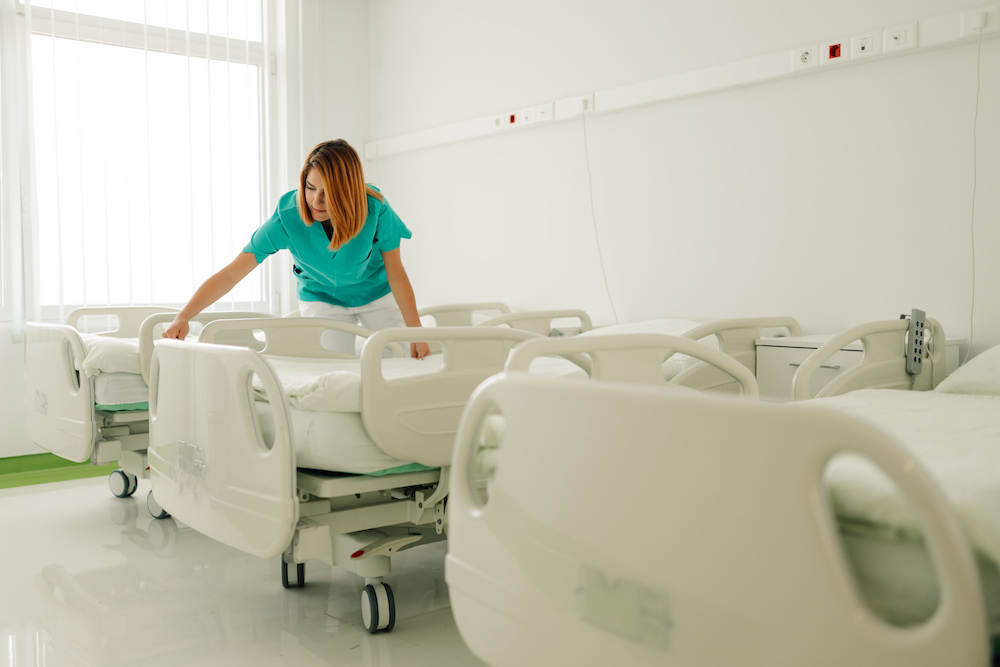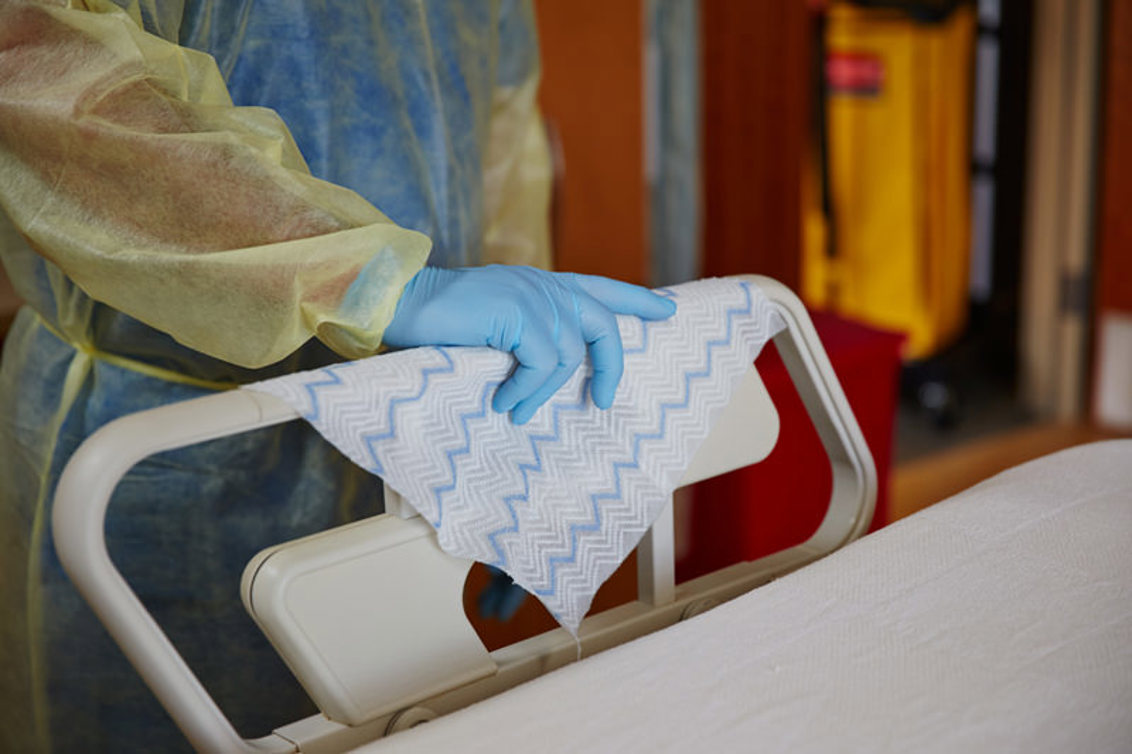
Healthcare-Associated Infections (HAIs) remain one of the most significant challenges facing hospitals today. In Australia, an estimated 165,000 patients develop an HAI each year, contributing to longer hospital stays, increased costs, and preventable harm to patients and staff.
Despite heightened awareness and strict infection control policies, many facilities still rely on outdated cleaning practices that fall short of current research. Surfaces, often touched hundreds of times a day, play a critical role in the transmission of pathogens. Yet, the products and methods used to clean them don’t consistently achieve the level of hygiene hospitals require.
Recent studies and field trials have shown that advanced microfibre technology can measurably reduce infection risk. The evidence highlights an opportunity for healthcare facilities to move beyond convenience-based cleaning and adopt science-backed solutions that improve patient outcomes and operational efficiency.
Healthcare-associated infections continue to place patients and healthcare workers at risk across every healthcare setting. These are acquired during hospital care and are caused by bacteria such as Staphylococcus aureus and Pseudomonas aeruginosa, which can survive on surfaces for extended periods. When healthcare staff or equipment make contact with contaminated surfaces, cross-contamination can easily occur, spreading infection to other rooms and patients.
Surface cleaning is one of the most effective infection control measures available to hospitals. Yet, many facilities still use wipes or products that only kill bacteria on contact, leaving behind soil, dirt, and residues that compromise disinfection performance. Studies show that 20–40% of HAIs are linked to contaminated surfaces, highlighting the importance of consistent, appropriate cleaning practices for infection prevention.
Beyond patient safety, HAIs carry a significant human and financial cost. Each infection can add days to a hospital stay, increase the use of disinfecting chemicals and antibiotics, and place pressure on already stretched healthcare budgets. Infection prevention teams and Environmental Services (EVS) staff must balance effectiveness, time, and cost while maintaining high cleaning standards across wards, operating theatres, and patient rooms.
Reducing infection risk requires more than cleaning for appearance. It demands products proven to remove pathogens, minimise exposure, and support measurable outcomes in every healthcare facility.
Many hospitals still rely on conventional wipes and pre-moistened cloths for surface cleaning, believing they offer a quick and easy solution. In practice, these products introduce significant risks in healthcare settings. Independent tests show that wipes lose effectiveness after cleaning just one to two square feet. Once saturated, they can spread bacteria across multiple surfaces, rather than eliminate them.
Wipes also depend heavily on disinfecting chemicals and alcohol-based formulations to kill bacteria and viruses. These solutions require long contact times to work effectively, a condition rarely met in a busy healthcare environment. When not used in the correct manner, the result is incomplete pathogen removal, leaving harmful microbes to survive on surfaces for extended periods.
Soil and dirt further reduce the power of these chemicals, creating invisible contamination that compromises infection control. In real-world hospital cleaning, this can mean hundreds of surfaces left inadequately sanitised each day. For patients, this increases the risk of exposure and acquired infections that are difficult and costly to treat.
Even well-trained staff face challenges when using single-use wipes. Frequent disposal, inconsistent moisture levels, and poor compatibility with hospital disinfectants can slow workflows and increase costs. In contrast, modern healthcare cleaning methods, such as microfibre systems, are designed to mechanically trap and remove microorganisms rather than relying solely on chemicals.
To protect patients and staff, hospitals need surface cleaning solutions that go beyond temporary disinfection. Cleaning methods must remove, not just kill, pathogens. Delivering reliable infection prevention outcomes that meet hospital cleaning standards across every healthcare facility.

Our latest White Paper reveals strong evidence that advanced microfibre systems outperform conventional wipes and cloths in removing pathogens, improving cleaning consistency, and reducing chemical exposure. The findings highlight how measurable performance leads to safer outcomes for patients, staff, and visitors alike.
Tests conducted across multiple healthcare settings showed that HYGEN™ Disposable Microfibre Cloths achieved up to 99.79% pathogen removal. Unlike wipes that rely on disinfecting chemicals to kill bacteria, microfibre physically traps and removes microorganisms from surfaces, leaving them cleaner for extended periods. This mechanical action reduces the risk of re-contamination, providing hospitals with a more reliable layer of infection control.
Independent reviews also demonstrated wider surface coverage, reducing missed areas during daily cleaning. That means fewer bacteria remain on high-touch surfaces such as bed rails, door handles, and medical equipment. These are areas where cross-contamination most often occurs.
Research conducted at Albert Einstein Hospital in Brazil demonstrated that replacing conventional wipes with HYGEN™ Disposable Microfibre significantly improved cleaning efficiency. Cleaning time was reduced by 19–27%, while chemical use dropped by 47%—a measurable gain for infection prevention teams managing high patient turnover and demanding schedules.
These findings confirm that adequate infection control does not depend on heavier chemical use. HYGEN™ Disposable Microfibre delivers superior cleaning performance using less water and no pre-soaked disinfectants. This reduces costs, minimises staff exposure to harsh chemicals, and supports safer cleaning practices across healthcare facilities.
These outcomes support the Australian Guidelines for the Prevention and Control of Infection in Health Care, which call for validated, measurable, and safe cleaning methods for people and the environment. This demonstrates that microfibre technology is a proven advancement in healthcare cleaning performance, helping facilities achieve higher standards of infection prevention and patient safety.
True progress in healthcare cleaning is about measurable outcomes hospitals can trust. The data provides clear, quantifiable improvements in infection control performance. Hospitals that implemented HYGEN™ Disposable Microfibre reported greater consistency in surface cleaning results, reduced cross-contamination risks, and improved compliance with hospital cleaning standards.
These highlight the importance of using validated tools that deliver predictable performance in every clean. Healthcare facilities can measure the real impact of their cleaning programs and continuously improve infection prevention strategies.
The findings highlight a clear path forward for hospitals: cleaning methods that prioritise removal over reaction. That’s where HYGEN™ Disposable Microfibre Cloths play a crucial role, providing infection prevention teams with a reliable, research-backed system designed for performance and safety.
Unlike wipes that depend on alcohol or disinfecting chemicals to kill bacteria, HYGEN™ cloths work through precision-engineered fibres that lift and trap contaminants from surfaces. This physical removal process captures pathogens and dirt, not spreading them. The result is consistent cleaning outcomes that support infection prevention targets across the entire healthcare facility.
The single-use design also addresses one of the biggest risks in hospital cleaning — re-use across rooms or departments. Each cloth is disposed of after use, reducing the chance of cross-contamination and maintaining cleaning integrity from start to finish. HYGEN™ Disposable Microfibre Cloths are compatible with a wide range of hospital disinfectants and are suitable for patient rooms, operating theatres, and other high-risk areas.
Each cloth delivers proven coverage and performance, helping Environmental Services teams clean more efficiently with less effort and waste. Colour-coded options support compliance with hospital cleaning standards by separating tools for different zones and applications.

Behind every clean patient room is a team under increasing pressure. Environmental Services (EVS) staff work in fast-paced healthcare settings where time, safety, and accuracy must align. The tools they use directly affect not just cleaning outcomes, but also their well-being and job satisfaction.
Traditional cleaning tools can slow down workflows and cause repetitive strain. HYGEN™ Disposable Microfibre Cloths are lightweight and ergonomically designed to simplify repetitive tasks. Their single-use format eliminates the need for laundering and handling heavy, soiled textiles, reducing physical fatigue and freeing up time for higher-value infection control duties.
Consistency matters as much as speed in hospital cleaning standards. With HYGEN™ Disposable Microfibre, every cloth performs to the same high level—no degradation, no variability. This helps EVS teams maintain confidence that every surface cleaned meets infection prevention requirements, even under demanding conditions.
When cleaning teams have access to systems designed for real-world healthcare environments, their work becomes more efficient, safer, and more rewarding. By making each clean easier, faster, and more effective, HYGEN™ Disposable Microfibre supports the people on the frontline of patient safety.
Preventing Healthcare-Associated Infections (HAIs) starts with proven, measurable cleaning practices that reduce contamination at the source. For hospitals, that means moving beyond short-term disinfecting methods toward solutions that consistently remove pathogens and protect both patients and staff.
At Rubbermaid Commercial, we design our systems around real research and real results. The HYGEN™ Disposable Microfibre Cloth reflects that commitment. Our product combines precision cleaning performance, safer handling, and greater efficiency to help healthcare teams stay in control of infection risks across every healthcare setting.
As infection prevention standards continue to rise, hospitals adopting evidence-led cleaning tools will lead the way in creating cleaner, safer environments for patients, visitors, and staff.
For healthcare professionals seeking to improve infection control outcomes, download our Healthcare Disposable Microfibre White Paper to see the full research behind HYGEN™ Disposable Microfibre technology.